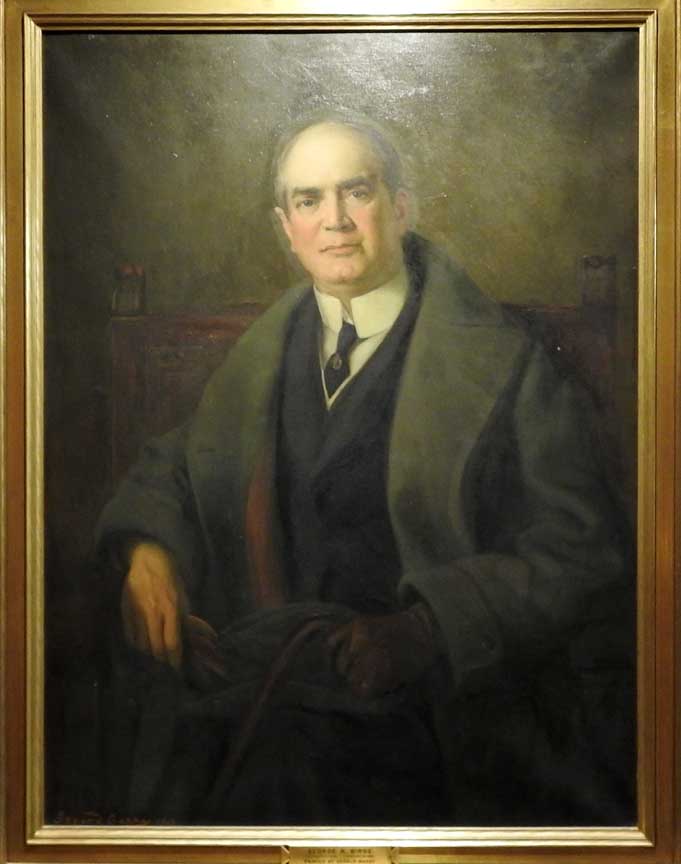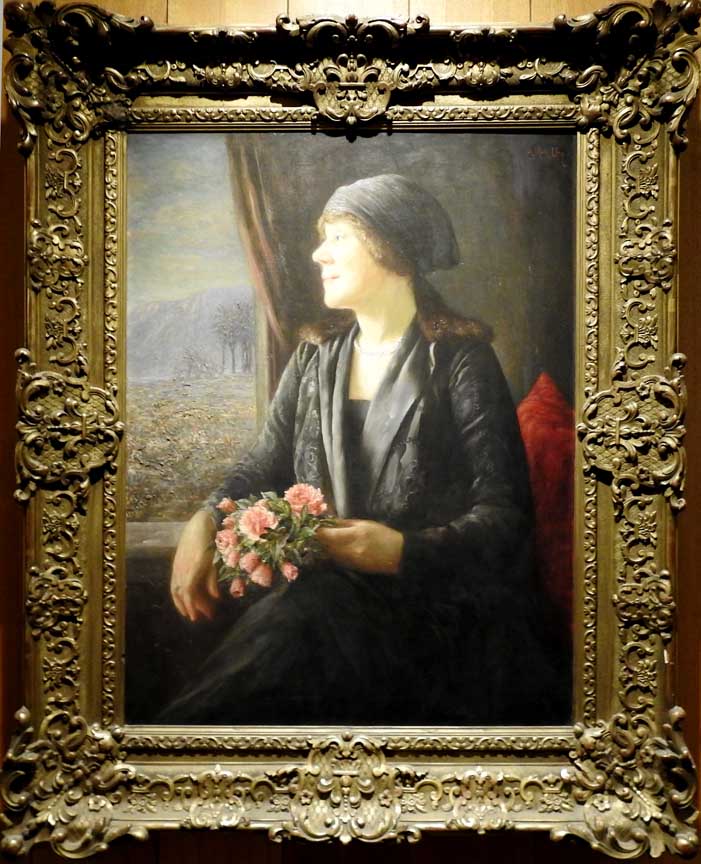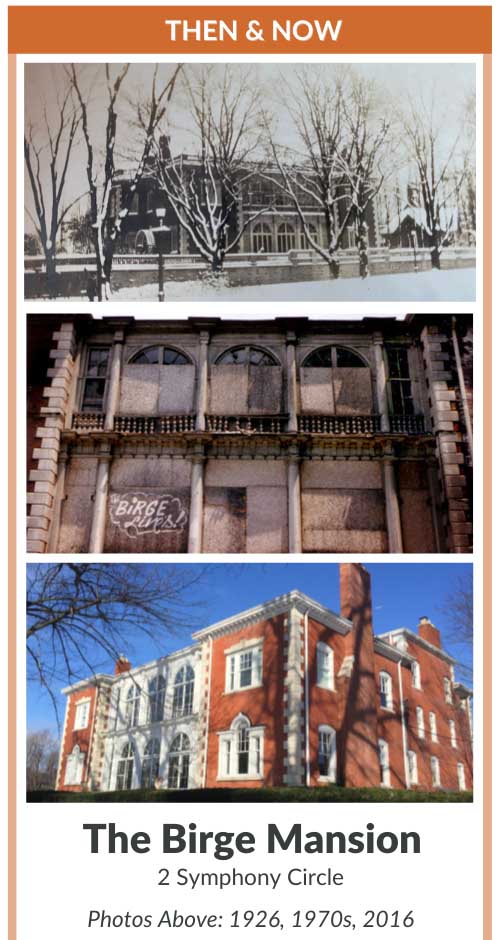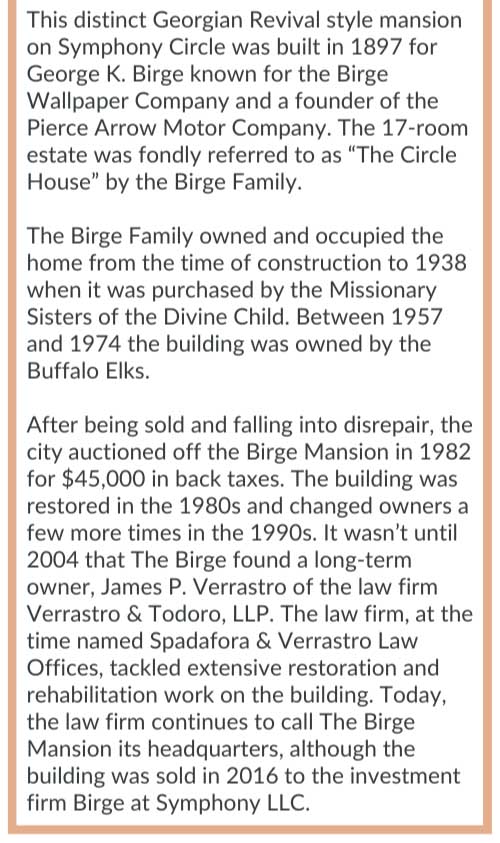George K. Birge - Table of Contents
George K. Birge House
(also known as the Circle House)
2 Symphony Circle, Buffalo, New
York
George K. Birge Memorial
Section 23, Forest Lawn Cemetery, Buffalo, New York


UB
Special Collections: Gerald Barry, George K. Birge
and Ury Mueller,
Carrie H. Birge
TEXT Beneath Illustrations
|
Birge Mansion on Symphony Circle |
Center section incorporates three arched windows |
Cornice includes modillions and dentils. |
Note keystone in splayed lintel |
|
Balustrade above modillions and dentils. |
Georgian Revival style arched windows |
||
|
|
|||
|
Neighbor: First Presbyterian Church |
Neighbor: Maythem/Millonzi Houses |
Poster |
|
| . | . | . | |
|
Birge Memorial east of Mirror Lake |
Scajaquada Creek |
||
|
Greek Revival style: 12 Doric style columns |
Classical swag above name on sarcophagus |
||
|
George Cary, Birge's son-in-law |
Born in Buffalo, 1849. Educated in the public schools, Buffalo Academy and Cornell University.
Upon leaving the university, Birge entered the wallpaper establishment (founded in 1834) of his father, Martin H. Birge, and was soon admitted partner, the firm style being M. H. Birge and Co. Later Henry M. Birge became a member of the house, which became M. H. Birge & Sons. This partnership continued until 1890, when it sold out to the National Wall Paper Co. In 1900 the original proprietors bought back the business, establishing the corporation since widely known as the M. H. Birge & Sons Co., of which George K. Birge was president. The company, located at 390 Niagara Street, was famous for the 12-color process of wallpaper production.
The company maintained branches in Chicago, New York, San Francisco, St. Louis, Boston, and London, England. Its products were sold throughout he U. S., Europe, South America, South Africa, and Australia.
The Pan-Am
Mr. Birge was elected a director and Executive Committee member of the 1901 Pan-American Exposition. He was also a member of the Building Committee, along with J. N. Scatcherd, Col. W. Symons, Carlton Sprague, and Harry Hamlin.
Pierce-Arrow
In 1880 George N. Pierce was making bird cages and refrigerators on Hanover Street. In 1891 he moved into bicycles and then cars.At this point George K. Birge and some friends bought into Pierce's business, which in 1899 Birge reorganized and brought in Scottish engineer David Fergusson. Reliance on steam power was abandoned, and in 1900 a gas-powered Motorette was placed on the market. Two years later the company was making its own engines and a year after that was selling the fifteen horsepower Arrow and the twenty-four horsepower Great Arrow.
The Arrow automobile continued to be made in the same bicycle plant on Hanover Street until 1907, when the company split into two companies and the auto production was moved to a new plant that was built next to the New York Central Belt Line Railroad on Elmwood Avenue at Great Arrow - land once occupied by a portion of the Midway of the 1901 Pan-American Exposition- covering fifteen acres of land. The complex had one million, sixteen thousand four hundred square feet of floor space for over 10,000 workers.
The architect for the administration building on Elmwood was George Cary. It seems fitting that Cary was the architect because he was one of the three local architects on the Pan-Am Board of Architects. Cary's masterpiece was the New York State Building for the Pan-Am- now named the Buffalo & Erie County Historical Society Museum - which is located several blocks south of the administration building on Elmwood Avenue at Nottingham Terrace.
In a fit of pique, Pierce withdrew from management in 1908. Birge was president of the auto company from 1908-1916.Publicity after victory in a 1908 cross-country race caused sales to climb, and in 1909 the company was renamed Pierce-Arrow, with Birge and associates as chief officers.
The first Pierce-Arrow showroom was the razed Vernor Building at 752-758 Main Street next to the now razed Teck Theater.When Birge retired in 1917 he withdrew half of his shares, which came to to $7,000,000.
By this time he had also made a success of the Birge wallpaper company.
Family lifeBirge married Carrie Humphrey, a daughter of the Hon. James H. Humphrey, who represented Buffalo in Congress during the Civil War period and later received honors of the bench. The children were Humphrey, Marion (married Thomas B. Lockwood), and Allithea (married George Cary).
477 Delaware Avenue, one of the Midway row houses, had been built by Birge in 1895. (In 1897 George's brother Henry and his wife were living there.)
Birge Mansion, 33 Symphony CircleThe Georgian Revival style mansion was built in 1896-1897 for George K. Birge. It was designed by the prestigious architectural firm of Little and Browne of Boston, Massachusetts.
The house was modeled on the lines of a villa Birge had seen on the Riviera. Two pavilions, cornered with stone quoins and housing Palladian and tri-part windows, flank a center section which incorporates three arched windows supported and separated by two tiers of Tuscan columns, and fronted by faux balustrades at the second floor.
The building was recently acquired by the Buffalo Philharmonic Orchestra. After renovation, it will house offices for both the BPO and the BPO Women's Committee. Both groups presently (August 2001) have offices in the Maytham Houses.The building's first nonresidential use was as the Sisters of Divine Child Convent from 1938 through 1957, followed by a nearly 20-year stint as an Elks Club. It fell into serious disrepair in the midd-1970s, becoming a flop house and a party site for drunks and junkies and the scene of several small fires. In 1982, a group of small investors led by John Chew purchased the building.
For history of Symphony Circle, see The Circle and Richmond AvenueSee also: Highlights of Buffalo's History, 1897
Birge MemorialThe Birge memorial erected on the lawn overlooking Crystal Lake was constructed of white marble, a simply styled sarcophagus resting on a wide round platform surrounded by twelve Doric columns.
The memorial was constructed by his wife, Carrie.
The design of the memorial is attributed to George Cary, who also designed the Forest Lawn administration building and remodeled the Delaware entrance. Cary married Birge's daughter Allithea. Cary also designed the administration building of the Pierce-Arrow Company (1906-08) of which Birge was original stock holder and president from 1908-1916.
Lockwood Memorial LibraryThe University of Buffalo's Lockwood Memorial Library (1933-1977) was the gift of Thomas B. Lockwood (1873-1947), and his wife, Marion Birge Lockwood, in memory of Daniel N. Lockwood and George K. Birge.
Sources:
- Forest Lawn Cemetery: Buffalo History Preserved. Richard O. Reisem, ed. Pub. by Forest Lawn Heritage Foundation, 1996.
- Kleinhans Community Association, "Symphony Circle"
- Brown, Richard C. and Watson, Bob. Buffalo: Lake City in Niagara Land, USA: Windsor Publications, 1981.
- "108-year-old Birge mansion to become law offices," by Sharon Linstedt, published in the February 17, 2004 The Buffalo News
- Buffalo's Delaware Avenue: Mansions and Families, by Edward T. Dunn. Pub. by Canisus College Press, 2003
See also:
- George Birge was a member of the Pan-American Exposition Board of Managers. For a list of other Board members who are also buried in Forest lawn, see Leaders of the Pan-American Exposition Buried in Forest Lawn Cemetery, Buffalo, New York
- Forest Lawn Cemetery on the Web Links to photos and history of well-known Buffalonians and their memorials, which are often works of art
- Pierce-Arrow Society (online June 2014)


